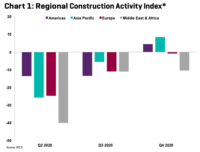A $480-million dollar arena slated to house the National Hockey League’s Edmonton Oilers is emblematic of recent development and economic recovery in Alberta's capital city. Institutional projects top 2013's robust building permit activity and represent the highest increase in year-to-date construction value, up 684% compared to 2012, say city officials.
“The arena is creating spinoff developments,” says Alan Kuysters, Edmonton district manager for PCL Construction Cos., the local firm handling project pre-construction work. “Several colleges in Edmonton are also building…the poly-technical school has a $240-million facility in the works. So that is contributing to the strong institutional permits.”
The need to educate, house and transport a growing population is the primary force promoting Edmonton construction projects, and economic recovery. Net immigration to Edmonton is three times the Canadian national average, and the vacancy rate is down dramatically. “There’s been a real run up in the development of multi-family dwellings driven by good labor,” said City of Edmonton Chief Economist John Rose. “Our unemployment rate is near 4.4%, while the average in Canada is 7.2%.” Residential building permits are up 31%, commercial is up 1%, and industrial is down 77% compared to 2012.
Building permits are usually considered a strong economic analysis tool, and are signaling strong fundamentals Edmonton— construction value through April 30 is at $1.56 billion. Year-to-date values are up 60% compared to 2012 ($977 million) and up 85% compared to the five-year average (YTD 2008-2012: $846 million), according to city officials.
For Edmonton, the recession is over, Rose says, and its strong employment numbers come from significant growth in the financial, manufacturing and industrial sectors. “We’ve seen a real renaissance in manufacturing, especially in modules and equipment for industrial operators, and that has required the construction of new floor space,” he says. “The new arena really blew the roof off the numbers in March, but building permits are still holding up very strong,” Rose says.
PCL has also noticed gains in the manufacturing sector. “The warehousing sector has grown and these facilities are being built on a bigger scale like we haven’t seen here before,” Kuysters says.
Responding to the pressure of population growth on its aging infrastructure, the city has also seen a “big push” to complete numerous transportation projects. “Construction on the Anthony Henday ring road around the edge of Edmonton is really moving forward,” Kuysters says. This is a $4-billion job started in 2000 with Flatiron Corp., Denver, as the main contractor. “There’s a tender out for a major bridge, the Walter Dale, on the south side of the city and expansion of the llght-rail transit system as a major private-public partnership (P3) will begin work sometime in 2014.”
Despite the activity within the city of Edmonton, Alberta oil sands construction projects further north near Fort McMurray are still providing jobs and growth. Particularly, “The Northwest Upgrader” which will allow for the processing of “dirtier” crude oil feedstocks into diesel fuel, will be worth “tens of billions” when finished, Rose says. Contractors Lurgi PSI, SNC Lavalin, IJK Consortium and PCL all are involved in Phase 1 of the project worth an estimated $5.4 billion. “Edmonton is sustainable by itself, but it does serve as a base of support for the mining work near Fort McMurray, and those dollars are coming back to the community and being spent in Edmonton, so housing and retail are seeing construction,” Kuysters says.
When there’s a sector like crude mining, however, that can afford to pay excessively high wages, it can actually cause adverse economic effects—other projects are slow going as workers get lured away to mining sites or refineries. Indeed, most of the workforce for oil sands mining comes from Edmonton, but a labor shortage is not a concern for PCL. Kuysters says the local work force usually builds as the jobs come, but PCL keeps relations ongoing with pools of off-shore workers who might be needed to complete projects. “A bigger concern is a competent management workforce,” he says. “We’re dealing with a lot of retirements and having to replace managers. On the craft work side, we’ve got some good industry pressure back through the high schools to get youth interested in the fact that a trade craft can be their livelihood. ”


